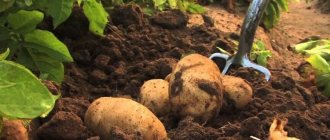The essence of the method
If you need to plant tubers in small beds, many gardeners use the “shovel” planting method. This means that when planting potatoes in open ground, they are planted almost to the depth of a spade bayonet.
This planting method is often used on light and loose soils, where groundwater lies quite deep. After planting potatoes in this way, many gardeners create small earthen mounds around the stems of the plant, because the bulk of the productive stems are located deep in the ground, and there is no need to rake a lot of earth onto the plant.
Optimal depth
It is quite difficult to choose the optimal depth for planting, since it mainly depends on the selected variety and type of soil on which the potatoes will be planted. On average, the depth of the hole varies from 5 to 10 cm. If we consider heavy soil, then the depth of the hole is no more than 5 cm. And for light black soil it can reach 15 cm.
The size of the planting tuber also plays a role. So, it needs to be sprinkled with earth to a depth of about 5 cm. If the potatoes are small, then you can make 5 cm indentations, but for large ones you will need a hole up to 10 cm deep.
Choosing a landing site
Before choosing this planting method, you need to make sure that the site is suitable for growing this vegetable crop:
- Character of the soil . Chernozem soils are excellent because they will supply the plant with all the nutrients it needs. In addition, such soils have good water and air permeability. Potatoes can also be planted on clay and sandy soils. To improve the quality of clay soil, it is worth supplementing it with sand or peat, but sandy soil can be improved with peat.
- Soil reaction . If a buttercup or plantain grows from weeds in a garden bed, then the soil is acidic, and if there is a birch or sow thistle, it is neutral. Acidic soil needs to be turned into neutral, and for this it is enough to add chalk, ash or lime at a ratio of 1-2 kg per 1 sq. m. m. plot.
- Previous cultures . Potatoes should be planted in an area where crops such as sunflowers, beets, corn, cucumbers or pumpkins previously grew. If potatoes were previously growing on the site, then they do not need to be planted in this place for another 4-5 years. If this rule is violated, the potatoes will be susceptible to disease and may also be affected by wireworms.
In general, the area should be small, since this planting method is classified as labor-intensive. It is desirable that it is well illuminated by sunlight and is accessible for watering. In addition, it is recommended to choose a place near which groundwater does not accumulate, and there are no other reasons for stagnation.
How to prepare the soil?
To plant potatoes, you first need to prepare the ground, which can be done in two ways. In any case, preparations begin in the fall, since the potatoes are planted in the spring.
Continuous application of fertilizer
Gardeners scatter manure, bird droppings or compost over the garden bed, and then dig up the soil and loosen it with a rake. It is recommended to remove any weed roots found in the area.
To prepare excellent fertilizer for potatoes, you can use this method:
- Remove all unnecessary mass from the garden in the form of various plant residues, weeds, roots and other plant components.
- Place all this in a compost heap or pit - a specially designated place where the collected compost will rot.
- Over time, it will become an excellent fertilizer.
There is another way to get organic fertilizer - to plant green manure crops on the plot in the fall, and in the spring, mow everything and manually bury it in the ground. Soon the crops will begin to rot, fertilizing the soil, so after 2 weeks you can plant the potatoes using a shovel.
If you are unable to prepare organic compost, you can use mineral fertilizers that are sold in stores.
Applying fertilizer in rows
If you need to dig up the soil and apply fertilizer at the same time, you can use this method:
- Just dig up the area with a bayonet shovel, removing all the weed roots so that they do not germinate further, otherwise in the summer you will need to spend a lot of time weeding.
- Apply fertilizer to the dug row, distributing everything evenly with a shovel so that there are no gaps.
- When digging the next row, cover the first one with soil so that the fertilizer remains in the bed, and not on the surface, and nourishes the potatoes during their growth and germination.
- In the spring, when digging the area, mix everything well again.
To ensure active growth of potatoes, you can use a mixture of fertilizers, for the preparation of which you mix 5 kg of manure and no more than 30 g of potassium phosphate.
Where to begin?
It is usually customary to plant potatoes under a shovel in small areas where it is impossible for machinery to enter. This method involves planting potatoes to the depth of a garden shovel. This option is possible on loose and light soil, but the groundwater must flow deep. When potatoes sprout, an earthen mound is created around the stems, without the need to rake a lot of soil. It is very important to choose the right place, soil and potatoes for planting, then you will get a rich harvest.
Tuber preparation
Potato yield largely depends on the choice of tubers. Initially, you need to select good varieties for planting, and then you can proceed to their processing. It is recommended to follow several steps.
- During the autumn period. All potatoes that will be used for planting should be sorted, and all small tubers, as well as damaged ones, are recommended to be removed immediately. Next, the tubers need to be poured out, forming one layer, and left for 2-3 weeks, excluding direct sunlight. This will allow the tubers to turn green, thereby gaining resistance to various diseases. To plant one hundred square meters, you will need from 500 to 700 tubers.
- In the spring. About 1 month before planting the potatoes, you need to go through all the tubers again to remove possible signs of rotting. Next, the planting material should be placed in a damp and cool place exposed to the sun's rays. If the moisture level is low, the tubers should be additionally sprayed with water. If the temperature exceeds +10 degrees, then the tubers can be kept outside.
- Before landing. If desired, potatoes can be dipped in a special solution of boric acid or potassium permanganate for half an hour. This action will make the planting material more resistant to various pests. If the potatoes are large, then they can be cut into several parts, but each of them should have strong but short sprouts.
Site preparation
Preparing the area for planting potatoes plays an important role. There are several factors to consider.
- The nature of the soil. Black soil is the ideal solution because it is full of nutrients. Such soil is characterized by excellent air and water permeability. Both sandy and clay soils are suitable for planting. To improve the quality of clay soil, you will need to add sand, and for sandy soil, peat.
- Ground reaction. You should take a closer look at what grows in this area. If the weeds are dominated by plantain or buttercup, the soil is acidic. Birch or thistle grows in neutral soil. To make acidic soil neutral, it is recommended to add 1-2 kg of lime, chalk or ash per 1 square meter.
- Preliminary plantings. Potatoes can be safely planted in areas where cucumbers, beets, corn, sunflowers or pumpkins previously grew. And after potatoes, it will be necessary to take a break for as long as 5 years, and only then will they be planted again in this place. If you ignore this recommendation, then the potatoes will hurt.
The area for planting potatoes under a shovel should be small, since this method is labor intensive. It is worth providing convenient watering and access to sunlight. In addition, there should be no groundwater flowing nearby.
Soil preparation needs to be done in the fall, since potatoes will be planted in the spring. There are two options for applying fertilizers that can be considered.
- Solid. You need to scatter compost, manure or bird droppings over the beds, then you will have to dig up the soil and loosen it with a rake. In the process, it is recommended to destroy the roots of weeds.
- In rows. This option is suitable if you need to apply fertilizer and dig up the soil at the same time. Initially, you need to dig up the area for planting with a bayonet shovel; fertilizer is applied to the dug row and carefully distributed. Then the next row is dug up, from which the soil covers the first row with fertilizer. This way, all the nutrients will flow to the potatoes. And in the spring, it is advisable to mix the fertilizer with the soil again when digging.
If you wish, you can make your own fertilizers for active potato growth by following these steps:
- collect remnants of vegetation from the site in the fall;
- place the collected mass in a compost pit or heap, where it will rot;
- the result will be excellent fertilizer in the spring.
Some gardeners apply fertilizer in a different way - green manure crops are planted on the plot in the fall, and with the arrival of spring it is necessary to mow the vegetation and dig up the soil. The plants will begin to rot, thereby fertilizing the soil. After two weeks, you can proceed to planting potatoes.
Preparation of planting material
Potato yield depends entirely on which tubers are planted in the spring. So, you should purchase good varieties of plants, and then start processing the tubers, which is done in three stages:
- In autumn . Sort through the planting material, removing tubers that are small or damaged. Then pour the potatoes in one layer and keep them in the light for 2-3 weeks, but not in direct sunlight. Soon the tubers will turn green and be disease resistant. It must be remembered that planting one hundred square meters will require from 500 to 700 tubers.
- In the spring . 1 month before planting, inspect the tubers and remove those that show signs of rotting or disease. Move good potatoes to a cool, damp place where the sun's rays penetrate. If the room humidity is low, the tubers should be sprayed moderately with water. They can be kept outside if the air temperature is not lower than 10 degrees.
- Just before landing . Potatoes can be kept in a solution of potassium permanganate or boric acid for 20 minutes, which will make them more resistant to pests. To stimulate plant growth, tubers can be sprayed with biostimulants.
Popular methods of pre-sowing processing of potatoes can be found in the table:
| Processing method | Benefit | Features of the technology |
| Gibberellin or Heteroauxin | Increases yield by 65 kg per hundred square meters. | A few days before planting, spray the tubers with a solution of the drug in a ratio of 7 mg per 1 liter of water. |
| Ferric chloride | Protects the crop from scab, which reduces the marketability of potatoes and shortens their shelf life. | Spray the potatoes with a weak solution of ferric chloride 2-3 days before planting. |
| Succinic acid | Helps nutrients remain in root vegetables, which improves their biochemical composition and taste. | A few hours before planting, treat the tubers with a 1% solution of succinic acid. |
| Wood ash | Increases the level of starchiness and nourishes the plant. | Treat the tubers before planting by dusting them with ash at a ratio of 1 kg of ash per 50 kg of potatoes. |
| Microelements | Nourishes potatoes with useful elements. | A few hours before planting, sprinkle the tubers with a solution of macroelements containing boron, manganese, copper in a ratio of 0.5 tsp. half a bucket of water solution. |
Before planting, large tubers can be cut, but in any case they should have strong and not too long sprouts that will not break off during planting.
What varieties can be planted without digging?
There are no special varieties for growing without plowing. For planting, it is best to take zoned potato varieties for the North-Western region - they are resistant to excess moisture and give a good harvest after a long, cold spring.
| Variety | Ripening time, days | Productivity, kg/acre | Sustainability | Characteristic |
| Adretta | 60-80 (early) | 450 | Viruses, cancer | Oval yellow tubers with yellow pulp, weight 100-150 g. |
| Aurora | 70-90 (average) | 210-410 | Cancer, golden nematode | Oval tubers of excellent taste with creamy pulp, weight 90-130 g. |
| Petersburg | 80-85 (average) | 300-370 | Late blight, viruses | Round beige tubers with white flesh, weight 90-120 g. |
| Bronnitsky | 80-100 (mid-late) | 380-440 | Late blight | Oval yellow tubers with yellow pulp of excellent taste and high starch content (16-18%), tuber weight 90-120 g. |
Early varieties do not have time to produce the usual outbreak of late blight. The main disadvantage of early-ripening potato varieties is that the tubers cannot be stored for long periods of time. For winter storage, high-yielding mid-season and mid-late varieties with good keeping quality of tubers are grown.
Time and methods of planting
As a rule, potatoes are planted in the ground in mid-April. Depending on whether it is early or late spring, planting time may shift to the beginning or end of the month. In this case, you need to be guided by the air temperature at night - it should be more than 10 degrees.
Potatoes can be planted in three ways:
- Square-nested . The bed is “divided” into squares, in the center of each of which a hole (nest) is made for a potato bush. The distance between the holes is from 50 to 70 cm.
- Chess . The holes are arranged like a honeycomb, that is, each next row must be started with a shift of half the distance between the bushes.
- Two-line (according to Mittlider) . Two rows (lines) are dug, and close to each other. Holes are made in each row at a distance of about 30 cm. Between every two lines you can create a gap of up to 1 m for passage. The holes of two joint rows must be placed in a checkerboard pattern, as in the previous diagram.
Square-nest method of planting potatoes
Chess method of planting potatoes
Two-line method of planting potatoes according to Mittlider
The bed should be located from south to north in order to achieve maximum illumination of the potatoes, because this way they will warm up and develop faster.
Regardless of the chosen scheme, potatoes should be planted under a shovel according to the following instructions:
- Drive pegs into the ground and stretch a rope or cord between them to dig even rows.
- It is advisable that at least two people do the planting: one should dig a hole, and the second should plant the potatoes. The optimal depth of the hole is 10-15 cm. Initially, you need to pour a handful of humus into it, and only then lay out the tuber with sprouts. Some gardeners resort to this trick - they throw in the seeds of bush beans along with the potatoes, since this can not only enrich the soil, but also increase the productivity of the plant. When working with potatoes, you need to be careful not to damage the sprouts.
- Use the earth dug for the holes of the next row to bury the holes of the previous one. If there is a third assistant, he can level the ground with a rake after planting, which will reduce moisture loss.
In general, it is worth maintaining at least 50 cm between rows, and from 20 to 30 cm between holes, in order to provide each plant with an optimal feeding area. Of course, the distance between rows and holes can be adjusted according to the potato variety and soil fertility.
If there are large tubers, deeper holes can be prepared for them, and the optimal distance between them is from 25 to 35 cm.
First hilling
If you planted using the Mittlider method, there is no need to hill up the crop. With other methods, ten days after planting, it is necessary to loosen the soil to saturate the soil with oxygen, and at the same time, if necessary, remove weeds. Important! After planting the crop, no matter what method was used, the holes are filled up, and the surface must be leveled with a rake, breaking up clods of earth.
Hill up for the first time when the tops reach a height of 20 cm. Carry out the procedure carefully so as not to damage the shoots. They are pulled apart, held by hand, and covered with soil, leaving only leaves on the surface.
Potato care
To reap a good harvest, you need to take proper care of the plant, from watering to fertilizing.
Watering
Water the plant during the growing season:
- When the first shoots appear. As a rule, this happens a week after planting. Before this, watering is not required, since the tubers have enough moisture contained in the soil.
- At the budding stage.
- After flowering.
Potatoes are watered quite rarely: once a week, and in dry times - 2 times. If sufficient rainfall occurs, watering can be canceled. It is completely interrupted 2 weeks before harvest.
Under no circumstances should the plant be allowed to overwater, as the soil should remain slightly moist and loose.
Loosening
10 days after planting the potatoes, the first loosening should be carried out, since it allows you to remove excess moisture and prevent rotting of the tubers. It is important to remove weeds along with their roots, as they thicken the soil, making it breathable and susceptible to infectious diseases. In addition, weeds prevent the full development of potatoes. Loosening should be done regularly.
Hilling
During the season, it is necessary to carry out 1-2 hillings, since this provides normal conditions for the formation of tubers - it helps to get rid of the earthen crust, saturates the soil with air, allowing the plant to “breathe”, and protects it from frost.
The first hilling is carried out after the potato tops have grown to a height of 10 cm, and the second - a week later, when the height of the tops is about 40 cm. For manual hilling, you need to use a hoe with a long handle, a hoe or a ripper. When hilling, you just need to lift the soil from the bottom up to the potato sprouts, gradually forming grooves.
Fertilizer
During the entire period of plant maturation, it is enough to apply 2 fertilizing according to the following scheme:
- For the first time - a month after planting.
- The second time, as soon as the potatoes bloom, the dose of fertilizer should be doubled.
Before applying fertilizer, you need to water the potatoes so that the root system is not burned by chemicals. Of course, it is worth using natural fertilizers, as they allow you to obtain environmentally friendly vegetable products. So, humus and wood ash are perfect for fertilizing. It must be remembered that an excessive amount of fertilizer can lead to excessive growth of the tops, which can damage the tubers.
To increase productivity, you can cover the row spaces in the garden bed with a layer of leaves or straw, since these wastes are not only excellent fertilizers, but also prevent moisture evaporation and weed germination.
Preparatory work
To reap a good harvest, you must not skimp on planting material. Never plant rotten or spoiled tubers - there will be few potatoes, and the soil will become infected with infectious diseases. Professionals recommend purchasing raw materials for planting from special agricultural companies with a good reputation.
In the fall, the material is sorted out to find spoiled specimens. Never store them with healthy tubers. The potatoes are kept in the sun for 20 days until they turn green. Using this method, the raw material is hardened and becomes resistant to many types of diseases. Remember: potatoes are not suitable for eating after the procedure.
In the spring, planting material is again inspected for the presence of rot and diseases. Suspicious tubers are always destroyed. Next, the root vegetables are transferred to a bright, cool room with good ventilation and high humidity. To protect seedlings from infections, they are immersed in a bucket with a solution of manganese or boric acid for several minutes. A quick awakening will be provided by chemical preparations - biostimulants.
Only ideal tubers are suitable for planting
Pros and cons of the method
Each method of planting potatoes has its own strengths and weaknesses, which are worth paying special attention to.
Pros:
- planting potatoes under a shovel allows you to get a good harvest with minimal resources;
- Potatoes grown using this method have high commercial quality;
- The harvested crop can be stored for 8 months.
Minuses:
- involves large amounts of energy because it is a labor-intensive method;
- It is difficult to provide potatoes with the right amount of nutrients, light, moisture and air.
Harvesting
Picture 5 High-yielding method of planting
Harvesting activities are carried out in dry weather. 10 days before digging up potatoes, the tops are cut off, which allows the root crops to accelerate ripening and the skin to become stronger.
Using a sharp shovel, holes are dug and the soil is turned over. The tubers are collected in buckets. The harvest dug up in this way can be stored for about 30 weeks.
By controlling the process of crop rotation and observing agricultural techniques for growing crops, you can grow healthy vegetable bushes, which will subsequently delight the owner of the plot with a hefty harvest.
Video: planting potatoes under a shovel
In the following video, the gardener will show how he plants potatoes in his garden bed:
Planting potatoes under a shovel is a method proven by many gardeners, which helps to get a good harvest if you follow all the above recommendations. At the same time, it is important to water the plant in a timely manner, weed away weeds and hill up. To increase potato yields, it is worth remembering about fertilizers.
0
0
Copy link
Scheme
When planting potatoes in different ways, different schemes are used. On average, it is recommended to adhere to the following parameters:
- distance between tubers - 30 cm;
- the gap between rows is from 70 cm to 1 meter;
- in a checkerboard pattern, each subsequent row begins with a shift of half the distance between the bushes;
- according to Mittlider, the tubers are laid out in double rows, while some should be at a distance of 1 meter, the holes in the rows are arranged in a checkerboard pattern.











